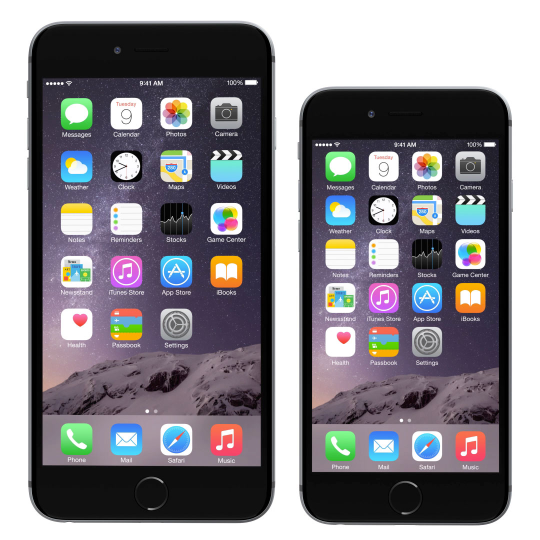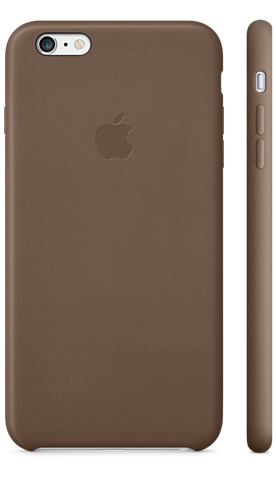iPhone 6 - 4.7-inch model revealed
The iPhone 6 was shown off at the Apple Event on 9.9.2014. The iPhone 6 and its larger brother, the iPhone Plus (size) model are available for pre-order from September 12 and can be collected from an Apple Retail Store from September 19. The iOS 8 mobile operating system has also been announced and will be downloadable two days prior to the iPhone 6 release on September 17.
Design
The new 4.7-inch iPhone 6 is shown above right, next to its 5.5-inch brother, the iPhone 6 Plus. Both are made with an ion-strengthened glass which mixes two ions together in order to give the covering more strength. This curves around the edges, complete with curved corners too (something Apple had gotten away from in recent iPhone models) and meets the back with its anodized aluminum material. There is no seam between the two materials.
The phone is made even thinner than ever because the larger surface area means the battery can cover a greater space and doesn't need to be quite as thick. So the iPhone is 0.27 inches thick, which compares to the iPhone 5S which is 0.30 inches thick. Not much of a difference but I guess it all counts.
It looks good and weighs only 129 grams.
Display
The 4.7-inch display with its oleophobic coating on the standard iPhone 6 offers 1334 by 750 pixels (326 pixels per inch). The color contrast ratio is 1400:1 and the brightness is approximately 500 cd/m2. The display has been named: Retina HD display.
For comparison, the iPhone 5S has a 4-inch display with 1136 by 640 pixels (326 pixels per inch) and an 800:1 contrast ratio. The display has dual-domain pixels said to provide better viewing angles.
Apparently apps designed for previous iPhone models will scale up just fine for this one. Likely this'll be the case because many look okay on the larger iPad mini anyway.
The iPhone 6 measures 5.44 inches high by 2.64 inches wide. The iPhone 5S measures 4.87 inches high by 2.31 inches wide.
The issue with the display is that 750p just doesn't cut it. The latter part of 2013 and early part of 2014 saw the proliferation of 1080p displays on Android and Windows Phone mobile devices. With video content being 1080p and increasingly 2160p now, offering a premium phone at a higher price than other mid-range Android phones with this low resolution is a poor showing by Apple.
Phones are now being released with pixels per inch over 500. One can argue that this isn't needed, but surely an expensive iPhone should offer better. Put another way, people with smaller hands who opt for the 4.7-inch iPhone 6 will be given an inferior viewing experience at a premium price. Nice.
Processors
Apple is now using the A8 chip which has second-generation 64-bit capabilities with 2 billion transistors. Apple claims the processor is 25% faster than the A7 chip with 50% faster graphics.
The company is still using dual-core processors but backing them up with hexa-core graphics. The main processor is a dual-core 1.4 GHz Cyclone (ARM v8-based) and the PowerVR GX6650 for the graphics.
Storage & Memory
There are three storage capacities: 16 GB, 64 GB and 128 GB. These all come with just 1 GB RAM.
The choice of 16 GB and then the leap to 64 GB is an odd choice. For entry-level buyers, they'll likely find that the 16 GB model is just too small but then be stuck with it. 32 GB can often be sufficient for such users, but this option isn't currently being offered.
The amount of RAM has been an issue for iPhone users who like to keep more apps open and have previously found the 1 GB limiting. For comparison, Android phones commonly have 2 GB or 3GB of RAM.
Communications
The iPhone has improved the 4G LTE band coverage from 13 bands to 20 which should cover most of the world. LTE Category 4 standard is supported for 150 Mbps downstream and 50 Mbps upstream (LTE category 6 with 300 Mbps downstream is now appearing on other mobile platforms).
Voice over LTE is introduced for making calls directly over the 4G LTE connection rather than using the cellular network per se. This is hardly a new feature for anyone who makes calls using Skype, Viber or LINE apps.
Wi-Fi has been upgraded to 802.11ac support to enable dual-band connections at greater distances. Wi-Fi hotspot is also included, subject to carrier approval.
NFC is now added to the iPhone. The Touch ID fingerprint sensor is again present. These come in useful with the new Apple Pay e-payment system introduced. A barometer has finally been added which is capable of checking elevation and air pressure. This will be used with the Health app in iOS 8.
Battery
The battery capacity is not yet known. Apple have said that the iPhone can play 60 hours of audio (a 20% improvement over the iPhone 5S), 11 hours of video, a bit more 4G LTE use and 24 hours of 3G talktime. Given that the iPhone 5S has a 1560 mAh battery, it would seem that this one is somewhere between 1750-1900 mAh capacity.
Cameras
The approach with the camera lens is to go with higher quality and better filters than to try to have larger megapixel cameras. As such, whilst Android and Windows Phone cameras are capable of producing enormous resolution images up to 20.7 megapixels, the iPhone 6 is still stuck back at just 8 megapixels for its rear-facing camera.
It does have a ƒ/2.2 aperture, Sapphire crystal lens cover, burst photo mode, auto image stabilization and better face detection though. The auto-focus feature called Focus Pixels is likely to be popular. A panorama mode can add several 8 megapixel shots together to create a 43 megapixel image which I guess is what you'll need to resort to if you want a larger image from your iPhone 6 camera.
Video recording is possible at 1080p resolution at 30, 60, 120 and 240 frames per second. The 120 and 240 fps provide slow motion video recording and playback. The crowd at the presentation was wowed with the slo-mo video playback, which tended to distract from the fact that 8 megapixels doesn't cut it any more, nor does 1080p video when 2160p video is the new standard with the latest smart phones.
The front-facing camera is only a 1.2 megapixel capable of images measuring 1280 by 960. There is a ƒ/2.2 aperture, burst mode and a few other tricks to take your selfie shot. 720p video recording is thrown in too. Most top phones can take 1080p video at 30 fps from the front these days.
No Landscape View
The iPhone 6 Plus has a landscape view that has been added for apps like Messaging, but this model remains portrait locked. It would have been nice to give the consumer the choice.
iPhone 6 Plus
The other iPhone option is the iPhone 6 Plus which offers similar functionality (adds an image stabilization feature for the cameras) and comes with a 5.5-inch display and 1080p resolution.
Conclusion
For fanboys of Apple gear, they'll probably love the new iPhone with 4.7-inches display. They'll overlook the low-resolution 750p display, low megapixel camera, lack of 2160p video recording, poor choice of phone storage options, lack of app landscape options, limiting battery size and minimal 1 GB RAM.
For realists, the price of Apple iPhones is considerably higher than other smart phones on the market. Mid-range Android phones match much of the features of the iPhone 6 at half the price. With the latest LG G3, Sony Xperia Z3, Samsung Note 4 and Samsung Note Edge, these phones beat both new iPhone specs without breaking a sweat (and the Note Edge has a curved right edge with functional display, not just a pretty reflection).
As one commenter stated, Apple has released last year's technology at next year's prices. This reviewer cannot agree more.
A downside might have been that developers would start making apps working well on 2 GB RAM and perform poorly on older iPhones with 1GB RAM.
Still, 1GB RAM is disappointing.


